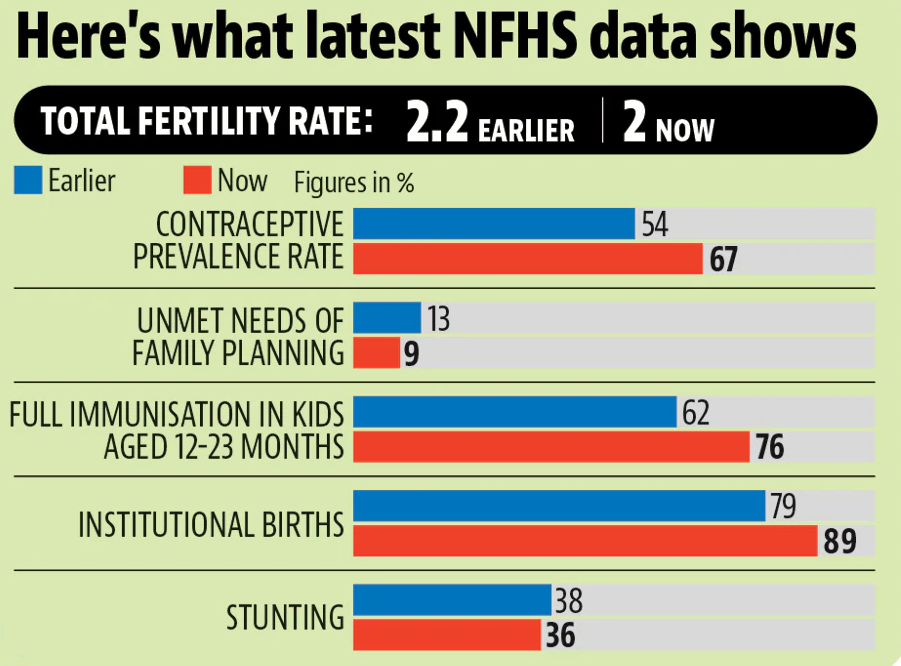Indian Society
India’s Declining Total Fertility Rate
- 26 Nov 2021
- 7 min read
Why in News
Recently, the latest data from the National Family Health Survey (NFHS 2019-21) has been released.
- The data shows a declining trend regarding Total Fertility Rate (TFR: the average number of children per woman).
Key Points
- About TFR:
- Total fertility rate (TFR) in simple terms refers to the total number of children born or likely to be born to a woman in her lifetime if she were subject to the prevailing rate of age-specific fertility in the population.
- TFR of about 2.1 children per woman is called Replacement-level fertility. TFR lower than 2.1 children per woman — indicates that a generation is not producing enough children to replace itself, eventually leading to an outright reduction in population.
- Declining Trend of TFR:
- Due to the sustained family planning programme spanning decades, the TFR, has declined further from 2.2 reported in 2015-16 to 2.0 at the all-India level.
- The TFR is at 1.6 in urban areas and 2.1 in rural India.
- The total fertility rate, was as high as 6 or more in 1950s
- It is a very huge development because of maternal and child health improvement.
- Due to the sustained family planning programme spanning decades, the TFR, has declined further from 2.2 reported in 2015-16 to 2.0 at the all-India level.
- Reasons for Decline in TFR:
- Women Empowerment: The latest data also show significant progress on several indicators related to fertility, family planning, age at marriage and women’s empowerment — all of which have contributed to the decrease in TFR.
- Contraceptives: Also, there has been a significant increase in current use of any modern contraceptive method.
- Contraceptive Prevalence Rate has increased substantially from 54% to 67% at the all-India level.
- Reversible Spacing: Introduction of new reversible spacing (gaps between children) methods , wage compensation systems to undergo sterilisation, and the promotion of small family norms also worked well over the years.
- Government Efforts: India has for long been working on population control. In fact, India was the first country to launch a national-level family planning programme and the encouraging results that we see now are due to sustained, concerted efforts put together by the Centre, and the state governments
Related Government Initiatives
- Prime Minister’s Appeal: During his Independence Day Speech in 2019, the Prime Minister appealed to the country that population control was a form of patriotism.
- Mission Parivar Vikas: The Government has launched Mission Parivar Vikas in 2017 for substantially increasing access to contraceptives and family planning services in146 high fertility districts with TFR of 3 and above in seven high focus states.
- National Family Planning Indemnity Scheme (NFPIS) : This scheme was launched in the year 2005 under this scheme clients are insured in the eventualities of death, complication and failure following sterilization.
- Compensation scheme for Sterilization Acceptors : Under the scheme, the Ministry of Health and Family Welfare provides compensation for loss of wages to the beneficiary and also to the service provider (& team) for conducting sterilizations from the year 2014.
- Significance of Declining TFR:
- Population Stabilisation: TFR of 2 is a “definite indicator” of stability of population in the long term in the country. A TFR of 2.1 is something a country wants to achieve.
- A fall to 2 means India has achieved the goal of population stabilisation.
- It essentially means that India need not worry too much about a very large population being a challenge to our development.
- Accelerated Economic Growth: The younger population profile for the next 2-3 decades will provide an opportunity for accelerated economic growth.
- However, in order to leverage this great opportunity for accelerated development, India should invest in public health and education with skills.
- Delayed Peak Population: This also means we will possibly still become the most populous country in the world — it was expected somewhere between 2024-2028 — but it will now be delayed.
- Population Stabilisation: TFR of 2 is a “definite indicator” of stability of population in the long term in the country. A TFR of 2.1 is something a country wants to achieve.
- Worrying Trends:
- Increasing Female Sterilization: The survey reveals that the uptake of female sterilisation has gone up to 38% against 36% in 2015-16.
- The increase in female sterilisation shows that the onus of family planning remains with women, with men not participating in the process and “shrugging responsibility’’,
- Declining Sex Ratio: India needs to give huge stress on declining sex ratios and the discrimination towards girls so that people don’t have a high number of children in the hope of having a boy.
- Concerns of Lower TFR: TFR lower than 2.1 children per woman — indicates that a generation is not producing enough children to replace itself, eventually leading to an outright reduction in population.
- Thus, TFR lower than 2 (as it is the case in urban areas in India) has its own set of problems. For example, Declining population will lead to an increase in the population of old aged people, as is happening in China.
- Increasing Female Sterilization: The survey reveals that the uptake of female sterilisation has gone up to 38% against 36% in 2015-16.
Way Forward
- Behaviour-Change Communication Strategy: The Government must adopt a targeted social and behaviour-change communication strategy to ensure that men also take responsibility for family planning.
- Environment Protection: Population stabilization doesn’t mean that India can divert its focus from environmental protection.







